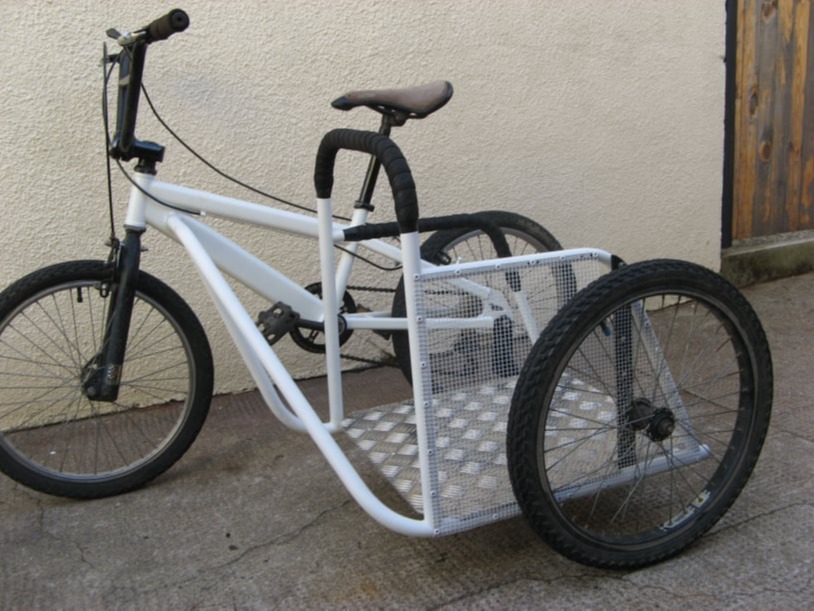
BMX Sidehack
A small chariot styled sidecar for a BMX bike, designed to do the nursery run on the local cycle paths.

A small chariot styled sidecar for a BMX bike, designed to do the nursery run on the local cycle paths.

The chosen bike was modified by welding two steel plates on either side of the head stock tube as shown. These plates were then drilled right through with a 25mm hole cutter.

The material chosen to construct the side car was 25mm and 20mm steel conduit. This was chosen because first of all, there was some being discarded in a nearby skip and secondly this allowed the use of a commercial pipe bender to form the frame. The pipe bender was rented for a day from the local tool hire shop.

First a piece of pipe with two bends was made to give the outside frame of the sidecar.
Some blocks of wood were cut to be used as jacks to set the height of the side car floor and the bike was held upright against the wall using a clamp on the rear tyre.
The height of the sidecar was 150mm from the ground.

Next the inner frame was made with a single bend to match the outer frame and this was brazed in place.
The front handle was made with 2 bends which were not quite 90º, so that the sides were slopping in towards the top. It was not possible to get the bends in the right place to align with the spacing at the bottom, so in the end the handle was cut into two parts and these were joined with a slug of steel along the top edge. This join would be covered with handlebar grip tape.

The side handles were bent as a matching pair. They were made from smaller 20mm conduit, as this was all that was available.
This photo also shows the front, lower crosspiece in place.
With all the bending complete, an off-cut of 25mm conduit was bent to create an offset seat post, in case the bike was too short for the rider.
Then the pipe bender was returned to the hire shop.

The front mounting through the two welded plates used the part shown on the left. This was manufactured from steel bar.
One diameter was to suit the hole drilled in the frame and the other was a tight fit in the conduit tubing.

The rear mount was made from steel plate. It was a simple angled part welded in situ to ensure an aligned fit. The vertical arm was angled forward to reach the rear wheel.

The outside wheel was cantilever mounted on a strip of steel which was taken from an old woodworking cramp (which was bent and useless).
As the sides of the passenger compartment were sloped, to get the wheel vertical the steel strip was mounted in the inside of the lower bar but the outside of the upper bar as shown here. An extra wheel nut was used between the wheel and mounting strip to space the wheel away from the frame.
The first position chosen for the sidecar wheel was too far forward. This gave good straight running but too much tyre scrub when turning. So the wheel was moved back so that it was about 50mm forward of the driving wheel. This position gave a good compromise between stability and cornering ability.

A quick road test confirmed that the sidecar was good, but the bike was way too small for the rider, despite the cranked seat post.
By chance my Nephew was discarding a larger BMX bike - still not quite full size but much longer.

The rear mounting had to be remade to fit the longer wheel base. It was also re-enforced with an angled brace for extra strength.

The sidecar is shown here painted in satin white.
Some garden mesh was riveted to the wheel side to protect the passenger and some aluminium tread plate was riveted to the base. This plate was 4.5mm thick and so required no extra support underneath.

The bike was painted in the same colour as the sidecar and this photo shows it after final assembly late one night.
Handlebar tape was added to the front and inside handle of the sidecar.



AI Website Creator